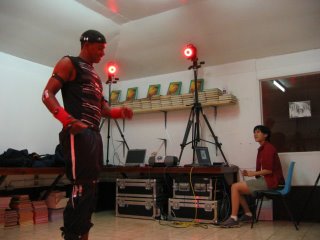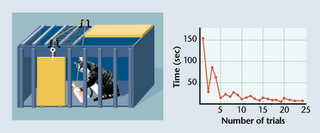Mapping the mind's black box.
The history of psychology is a relatively short but varied one, replete with many wrong turns. One of these is phrenology, the art and sometimes science of reading personality from bumps and recesses on a person's skull. Invented by
Franz Gall, phrenology's heyday expired near the end of the 19th century. The basic idea held that the brain was an organ like no other, for contained within its black box were several suborgans, each with a different function. Running with the idea that the size of an organ tells us something about its usefulness for the organism, Gall reasoned that we could deduce the relative importance of each suborgan for each person based on the imprint it made on the head. For a more complete picture of phrenology, check out this
excellent online phrenology resource from the British Library.
Like many wrongheaded ideas in psychology, phrenology has become like what astrology is to astronomy today. Neuroscience has come a long way since then, but we can still see vestiges of Gall's idea in the ideas from two founders of Evolutionary Psychology: Leda Cosmides and John Tooby.
First, more on Gall's organs.
He proposed 27 of them, listed below. The final 8 he thought were unique to humans but the rest we share with other animals.
- The instinct of reproduction (located in the cerebellum)
- The love of one's offspring
- Affection; friendship
- The instinct of self-defense; courage; the tendency to get into fights. The carnivorous instinct; the tendency to murder
- Guile; acuteness; cleverness
- The feeling of property; the instinct of stocking up on food (in animals); covetousness; the tendency to steal
- Pride; arrogance; haughtiness; love of authority; loftiness
- Vanity; ambition; love of glory (a quality "beneficent for the individual and for society")
- Circumspection; forethought
- The memory of things; the memory of facts; educability; perfectibility
- The sense of places; of space proportions
- The memory of people; the sense of people
- The memory of words
- The sense of language; of speech
- The sense of colors
- The sense of sounds; the gift of music
- The sense of connectedness between numbers
- The sense of mechanics, of construction; the talent for architecture. 20. Comparative sagacity
- The sense of metaphysics
- The sense of satire; the sense of witticism
- The poetical talent
- Kindness; benevolence; gentleness; compassion; sensitivity; moral sense
- The faculty to imitate; the mimic
- The organ of religion
- The firmness of purpose; constancy; perseverance; obstinacy.
What's really fascinating and what nicely captures the evolution of thought
on thought, is that Cosmides and Tooby's recent theory (1990s) builds on a century's old idea. C & T posit that humans have mental modules (number unknown) that have been forged over evolutionary time because each solves a specific problem our ancestors faced. This idea runs counter to the prevailing notion, the one argued by S. J. Gould, that our brain is a general problem solving device not a domain-specific one.
In the grand developmental scheme of psychology, EP is
practically prenatal so there's been a lot of theory, some great emblematic research published, and vanishingly few bona fide modules proposed, let alone confirmed.
That said, here's my list of some proposed modules mapped onto Gall's organs (in parentheses):
1) Selecting, Attracting & Reproducing with a Mate
(reproduction - located in the cerebellum)
~ Fieldnote:
Studied by David Buss & others. This module, like all of those proposed, incorporates many, many parts of the brain, including the
cerebellum (especially if you agree with
Geoffrey Miller that dancing is part of the courtship repertoire of our species). This is the sexiest line of EP research, and the most fun!
2) Differential Parental Solicitude
(love of one's offspring)
~ Fieldnote:
Studied by Robert Trivers & others. Bob stands out as one of the great evolutionary biology All-Stars; he gave us the theories of parental investment and reciprocal altruism that so many theories of evolutionary psychology depend on. It can help explain sibling rivalry among other things.
3) Forming, Maintaining, and Breaking Alliances / Networking(affection; friendship)
~ Fieldnote:
Studied by Trivers, Dawkins, Dunbar, et al. Sandwiched between this and number one sits my little line of inquiry.
4) Self-Defense / Aggression toward Others
(self-defense; courage; fights, murder, carnivorous instinct)
~ Fieldnote:
Studied by Buss. Note his
The Murderer Next Door.
5) Intelligent Problem Solving: Making Tools & Being Machiavellian
(Guile; acuteness; cleverness)
~ Fieldnote: This one was difficult to name. We could talk about modules for tool making & use, for social cunning, for creativity, etc. But I'll point you to Cosmides and Tooby's most celebrated:
the cheater detection module.
6) Selfishness
(feeling of property; covetousness; tendency to steal)
~ Fieldnote: Dawkins
The Selfish Gene has much more to say about this.
7) Self-Esteem
(Pride; arrogance; haughtiness; love of authority; loftiness)
~ Fieldnote: EPs posit that self-esteem is an organism's measure of how well it thinks it's solving survival and reproductive problems. Lost your job and haven't found one for months? You feel depressed / low self-worth because you have failed at several major problems - feeding & sheltering yourself & your dependents. You've probably also suffered a loss in your social position and ability to attract or retain a mate. States of temporary low self-esteem and depression send you the signal that what you're doing isn't working & that you'd better try something new.
**
In the interest of brevity, I'll fast-forward to the rest of the most interesting modules:
14) Language Acquisition Device (language; of speech)
~ Fieldnote: The LAD was first proposed by Noam Chomsky and later elaborated on by Steven Pinker. The central idea holds that through a freak accident of nature humans have acquired
universal grammar and the necessary brain architecture that allows any human, given the right stimulation (exposure to language) at the right time (before @ age 7), to produce sentences that obey rules of syntax.
Colorless green ideas sleep furiously is but one example.
23) Capacity to Imitate(faculty to imitate; mimic)
~ Fieldnote: "
Monkey see, monkey do" is not an entirely correct designation for our tailed primate relatives. Monkeys don't really imitate each other. Instead, the emulate each other. Monkeys, and indeed most nonhuman apes, get the general idea about how to do something by observing another (e.g. to solve a problem), but when it comes time for them to do it on their own, they nearly always go through some trail and error before stumbling on the same solution. This is one area where humans (at a certain age) surpass even the brightest of nonhuman apes. We humans are able to duplicate actions the first time we are shown, within reason of course: I've seen swimmers do flip turns but I'd bet my imitation would look downright sloppy. Humans learn by trial and error too, so when I say we have a greater capacity for imitation, I mean we can copy some actions perfectly that other apes cannot and that we may need fewer trial & error steps to achieve perfection.
24) Religion: Product of Consciousness of Our Own Mortality
(organ of religion)
~ Fieldnote: EPs propose that the little accident of nature that gave us consciousness also made us aware of our own mortality and that led us to invent religion as a way of assuaging the grim news. This is a line of thought I would like to know more about - when hell freezes over.
No seriously, I am not as familiar with this particular theory and research as I should be. There is a ton of it - see
here. Perhaps this is a decent place to start:
Attachment, Evolution, and the Psychology of Religion by Lee Kirkpatrick. Or maybe I'll see what a book already on my shelf has to say:
Philosophy in the Flesh.
Cosmides and Tooby's idea of modules and my brief map of a few of them here should convince you that:
a) Evolutionary Psychology could come to be viewed as just as thoroughly wrong-headed as Gall's phrenology
OR
b) With sufficient modification and elaboration, the descent of Gall's organs into C & T's modules will come to be viewed as the predominant paradigm in Psychology.
For that to happen, EP must incorporate findings from neuroscience into its theory of the modular mind. What I want to see is the identification of specific neurotransmitter pathways that activate/deactivate given specific sensory inputs and also the articulation of "filters" for stimuli or sensitivity thresholds so that we can explain individual differences in behavior. These have to be shown to be genetically constructed at some level but also subject to developmental and experiential modification.
Basically, any all-encompassing theory of human nature must also explain why there are individual differences in behavior.


























